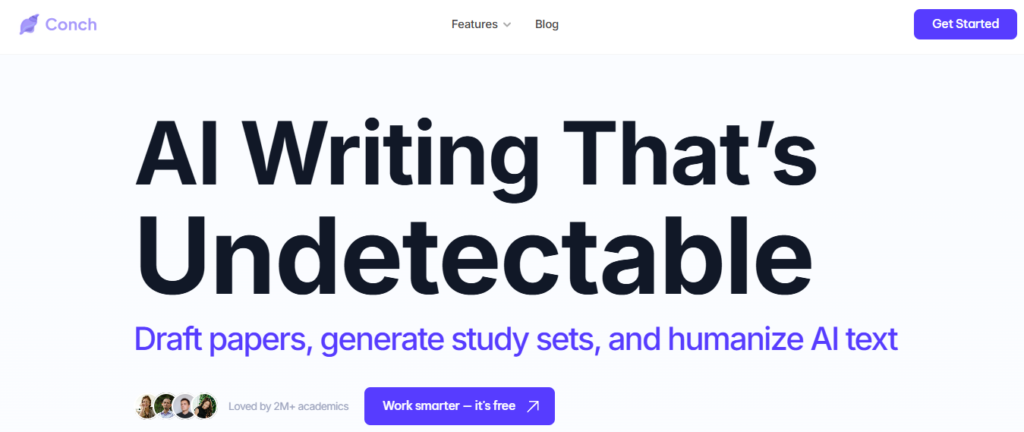You’re cramming for a history paper due tomorrow. You’re relieved to find a documentary that covers your exact topic. As you watch, you make notes on the documentary’s interesting interviews and archival footage, sure that this information will help you write an excellent paper. But wait. Is a documentary a primary source? What if you used this documentary’s interviews instead of citing the documentary itself? What about the archival footage? These are important distinctions to make when writing academically. If you’re unsure how to organize and present your research, learning how to use AI to write a paper can simplify the process—helping you identify source types, structure your arguments, and ensure clarity in your writing.
You might be surprised to learn that documentaries can have both primary and secondary source qualities, depending on how you use them. This blog will help you understand when and how documentaries can be considered primary sources versus secondary sources.
Conch AI’s AI writing tool can also help you tackle your upcoming history paper. With its innovative AI technology, this writing tool enables you to outline your paper, organize your notes, and even write a complete first draft.
What Is a Documentary?

A documentary is a non-fiction film crafted to educate, inform, or shed light on real-life events, people, or issues. It is a distinct cinematic form that combines factual storytelling with creative techniques to engage viewers and provide insight into the subject matter. Documentaries often employ a combination of archival footage, expert or eyewitness interviews, narration, and on-location shots to construct a narrative or present a particular perspective.
The term “documentary” was first coined in 1926 by Scottish filmmaker John Grierson, who described it as the “creative treatment of actuality.” This highlights that documentaries, while grounded in real events, also involve artistic interpretation and storytelling choices to make the material compelling and meaningful. Unlike fictional films, documentaries aim to present reality but often reflect the filmmaker’s viewpoint, which can shape how facts and stories are conveyed.
Documentaries serve multiple purposes. They can function as journalism, advocacy tools, educational resources, or personal expression. They often explore social issues, historical events, cultural practices, or scientific topics, providing audiences with a deeper understanding and sometimes challenging prevailing narratives. The genre has also been utilized historically for propaganda, particularly during wartime, demonstrating its ability to influence public opinion.
The strength of documentaries lies in their ability to introduce new perspectives and voices that may be absent from mainstream media or traditional educational materials. By combining factual content with storytelling, documentaries engage viewers on both an emotional and intellectual level, fostering awareness and sometimes inspiring action.
Related Reading
- How to Calculate H Index
- How to Write an Informative Essay
- Technology Essay
- How to Write a Header for an Essay
- How to Write a Biography Essay
- How to Write a Reflection Paper
- How to Write an Encyclopedia Entry
- Speech Analysis Example
- What is a Good H Index
Is a Documentary a Primary Source

A documentary can be either a primary or secondary source depending on its content and purpose.
Documentaries serve as influential tools in both research and education, offering rich visual narratives and storytelling. A primary source is typically an original, firsthand account or direct evidence related to a topic. Documentaries sometimes include such original material as interviews, footage, or artifacts, making parts of them primary sources. For example, a documentary featuring unedited footage of a historical event or firsthand testimonies can be considered a primary source for that event.
On the other hand, many documentaries provide analysis, interpretation, or commentary on events, which aligns them more closely with secondary sources. These documentaries synthesize information from various primary sources to present a broader understanding, rather than offering direct evidence themselves.
Because documentaries can contain both original content and interpretive elements, it is crucial to critically evaluate their purpose and content before incorporating them into research. Understanding whether the documentary presents raw data or an analysis helps determine how it should be cited and valued in your work.
When Can a Documentary Be Considered a Primary Source?

Documentaries are often viewed as secondary sources because they interpret or analyze events. However, under certain conditions, they can serve as primary sources, offering original, firsthand material that directly documents historical moments, cultural attitudes, or personal experiences. Understanding these scenarios helps clarify when a documentary is more than just an interpretation.
1. Firsthand Documentation of Events
A documentary becomes a primary source when it captures events in real time, providing direct evidence of what occurred. This includes footage filmed as events unfold without retrospective narration or analysis.
Examples
- Footage of the fall of the Berlin Wall as it happened.
- Live recordings of the 2004 Indian Ocean tsunami aftermath.
- Real-time coverage of the 1969 Woodstock music festival.
2. Original Interviews and Unique Footage
When a documentary contains exclusive interviews or footage not available elsewhere, it functions as a primary source. These elements provide raw, firsthand accounts from individuals involved in or witnessing the events.
Examples
- A filmmaker’s exclusive interview with a Nobel Prize winner discussing their breakthrough.
- Recorded conversations with refugees immediately after displacement.
- A documentary featuring a rare interview with a reclusive artist in their studio.
3. Capturing Social and Cultural Perspectives
Documentaries that record societal attitudes, public opinions, or cultural trends during a particular period serve as primary sources for understanding the social context of that time.
Examples
- A 1970s documentary exploring public attitudes toward environmental conservation.
- Film capturing the fashion and youth culture during the 1980s in New York.
- A documentary reflecting community reactions during the legalization of same-sex marriage.
4. Insight into Filmmaking and Representation
Beyond content, documentaries can be primary sources for studying the creative process and media representation. When a documentary reveals the filmmaker’s narrative choices, techniques, or biases, it provides original material for analyzing how history or culture is portrayed.
Examples
- A making-of documentary revealing how special effects were created for a historical drama.
- Behind-the-scenes footage shows editorial decisions in a political documentary.
- A director’s commentary on choices made to portray a controversial event.
Related Reading
- Essay on Respect
- Essay About Bullying
- Why I Deserve This Scholarship Essay
- Is Census Data Primary or Secondary
- Are Textbooks Primary Sources
- Essay About Death
- How to Write a 4 Paragraph Essay
- Finance Research Paper Writing
When Can a Documentary Be Considered a Secondary Source?

Documentaries can serve as valuable educational tools, but their classification as primary or secondary sources depends on how they present information. Specifically, a documentary is considered a secondary source when it interprets, analyzes, or synthesizes information rather than offering direct, original evidence. Below, we explore key situations where documentaries effectively fill this role, supported by relevant examples.
1. Interpretations of Events
Documentaries often provide an interpretation of historical or current events, shaped by the filmmaker’s viewpoint and research. Rather than simply presenting raw footage or firsthand accounts, they analyze the causes, consequences, and broader implications.
Examples
- A documentary exploring the causes and impacts of the Great Depression, featuring analysis from economists and historians.
- A film interpreting the civil rights movement, discussing its social and political implications through expert insights.
- A documentary on climate change that examines scientific data trends and policy debates rather than presenting new experiments.
- A documentary about the fall of the Berlin Wall that reviews political dynamics and international relations leading up to the event.
2. Expert Commentary
When documentaries include interviews or commentary from scholars, professionals, or specialists, they add interpretive layers that classify them as secondary sources. These expert perspectives help frame the subject matter within academic or professional discourse.
Examples
- A documentary on urbanization featuring sociologists explaining demographic shifts and their societal effects.
- A film about mental health that incorporates psychologists’ insights on diagnosis and treatment trends.
- A documentary on technological innovation with commentary from engineers and historians of science.
- A documentary about ancient civilizations featuring archaeologists discussing the significance of artifacts.
3. Compilation of Multiple Primary Sources
Documentaries often weave together various primary materials such as archival footage, interviews, and official documents to create a cohesive narrative. This synthesis transforms raw data into interpreted information, making the documentary a secondary source.
Examples
- A documentary on World War II that uses archival battle footage, soldiers’ letters, and government communications.
- A film on the space race combining NASA recordings, astronaut interviews, and contemporary news reports.
- A documentary about the feminist movement that includes speeches, personal diaries, and legislative texts.
- A documentary on the 1960s counterculture that integrates music performances, protest footage, and personal testimonials.
4. Historical Contextualization
Many documentaries place events within a larger historical or social framework, offering analysis that connects specific occurrences to broader trends or movements. This contextualization is a hallmark of secondary source material.
Examples
- A documentary on women’s suffrage that links the campaign to global gender equality efforts and societal changes.
- A film about the Industrial Revolution explaining its impact on urbanization, labor rights, and economic systems.
- A documentary on the Cold War that situates key events within ideological and geopolitical rivalries.
- A documentary on the abolition of slavery that traces its roots to economic, cultural, and political shifts over centuries.
How to Cite a Documentary

Citing a documentary properly depends on the citation style you are using and the type of documentary. Common styles include APA, MLA, and Chicago, each with its own format rules. Generally, you need key information such as the documentary title, director’s name, production company, year of release, and, if applicable, the platform or URL where you accessed it.
APA Style
In APA style, you typically list the director as the author, the year of release, the title in italics, and the production company.
For example: Director’s Last Name, First Initial. (Director). (Year). Title of documentary [Film]. Production Company.
MLA Style
MLA style starts with the documentary title, followed by the director’s name and role, the production company, and the year. If accessed online, include the streaming platform and the date you accessed it. In-text citations usually use the title and a timestamp for specific scenes.
Chicago Style
Chicago style often employs a concise format that lists the title, director, city of production, production company, and year. Footnotes are commonly used for in-text citations, including the title, director, and year.
To avoid confusion and ensure accuracy, you can use AI-powered citation tools like Conch AI. Such tools help you organize your sources and generate citations automatically in thousands of styles, directly integrating with writing software like Google Docs or Microsoft Word. This approach saves time and reduces errors, particularly when handling complex sources such as documentaries.
Related Reading
- Ai Annotated Bibliography
- Leadership Essay Examples
- Social Media Argumentative Essay Topics
- Topic Sentence vs Thesis Statement
- Evaluation Essay Examples
- National Honor Society Essay Examples
- Proposal Essay Examples
- Diversity Essay Examples
- Literary Analysis Essay Examples
- Informative Essay Topics
- Dyslexia Writing Examples
Join Over 2 Million Students and Ace your Classes with our AI Writing Tool

Join millions of students to write papers and ace exams with Conch AI’s AI writing tool. We built this tool because we were tired of spending endless hours on citations, study guides, and rewrites. Unlike general AI tools, Conch understands what students need – instant citations that professors accept, stealth writing that bypasses detection, and study tools that help you learn the material.
Our Chrome extension brings these superpowers right to your research workflow, while our lecture recording feature takes notes for you so you can focus on understanding concepts. Try our free plan today and see why students tell us they’re saving 10+ hours a week with Conch AI.
When you’re ready for unlimited access, our Limitless Plan gives you everything you need to transform your academic experience. Join over 2 million students and ace your classes with our AI writing tool!

Leave a Reply